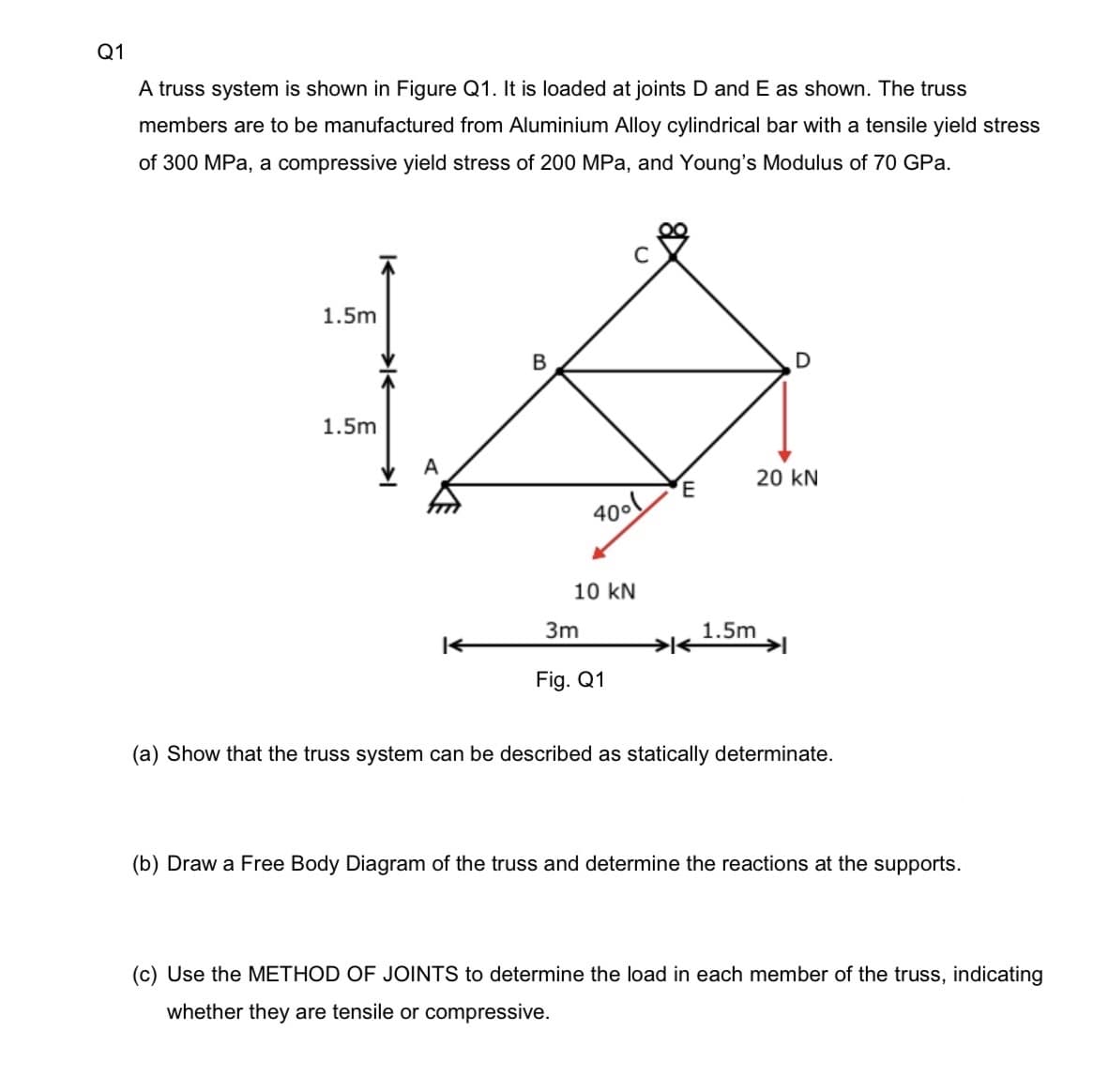Q1 A truss system is shown in Figure Q1. It is loaded at joints D and E as shown. The truss members are to be manufactured from Aluminium Alloy cylindrical bar with a tensile yield stress of 300 MPa, a compressive yield stress of 200 MPa, and Young's Modulus of 70 GPa. 1.5m 1.5m A B C 4001 10 kN 3m Fig. Q1 E 水 20 KN 1.5m D 키 (a) Show that the truss system can be described as statically determinate. (b) Draw a Free Body Diagram of the truss and determine the reactions at the supports. (c) Use the METHOD OF JOINTS to determine the load in each member of the truss, indicating whether they are tensile or compressive.
Q1 A truss system is shown in Figure Q1. It is loaded at joints D and E as shown. The truss members are to be manufactured from Aluminium Alloy cylindrical bar with a tensile yield stress of 300 MPa, a compressive yield stress of 200 MPa, and Young's Modulus of 70 GPa. 1.5m 1.5m A B C 4001 10 kN 3m Fig. Q1 E 水 20 KN 1.5m D 키 (a) Show that the truss system can be described as statically determinate. (b) Draw a Free Body Diagram of the truss and determine the reactions at the supports. (c) Use the METHOD OF JOINTS to determine the load in each member of the truss, indicating whether they are tensile or compressive.
Steel Design (Activate Learning with these NEW titles from Engineering!)
6th Edition
ISBN:9781337094740
Author:Segui, William T.
Publisher:Segui, William T.
Chapter1: Introduction
Section: Chapter Questions
Problem 1.5.6P: The data in Table 1.5.3 were obtained from a tensile test of a metal specimen with a rectangular...
Related questions
Question

Transcribed Image Text:Q1
A truss system is shown in Figure Q1. It is loaded at joints D and E as shown. The truss
members are to be manufactured from Aluminium Alloy cylindrical bar with a tensile yield stress
of 300 MPa, a compressive yield stress of 200 MPa, and Young's Modulus of 70 GPa.
1.5m
1.5m
A
B
4001
10 KN
3m
Fig. Q1
E
水
20 KN
1.5m
D
➜
(a) Show that the truss system can be described as statically determinate.
(b) Draw a Free Body Diagram of the truss and determine the reactions at the supports.
(c) Use the METHOD OF JOINTS to determine the load in each member of the truss, indicating
whether they are tensile or compressive.
Expert Solution
This question has been solved!
Explore an expertly crafted, step-by-step solution for a thorough understanding of key concepts.
Step by step
Solved in 6 steps with 6 images

Knowledge Booster
Learn more about
Need a deep-dive on the concept behind this application? Look no further. Learn more about this topic, civil-engineering and related others by exploring similar questions and additional content below.Recommended textbooks for you

Steel Design (Activate Learning with these NEW ti…
Civil Engineering
ISBN:
9781337094740
Author:
Segui, William T.
Publisher:
Cengage Learning

Steel Design (Activate Learning with these NEW ti…
Civil Engineering
ISBN:
9781337094740
Author:
Segui, William T.
Publisher:
Cengage Learning